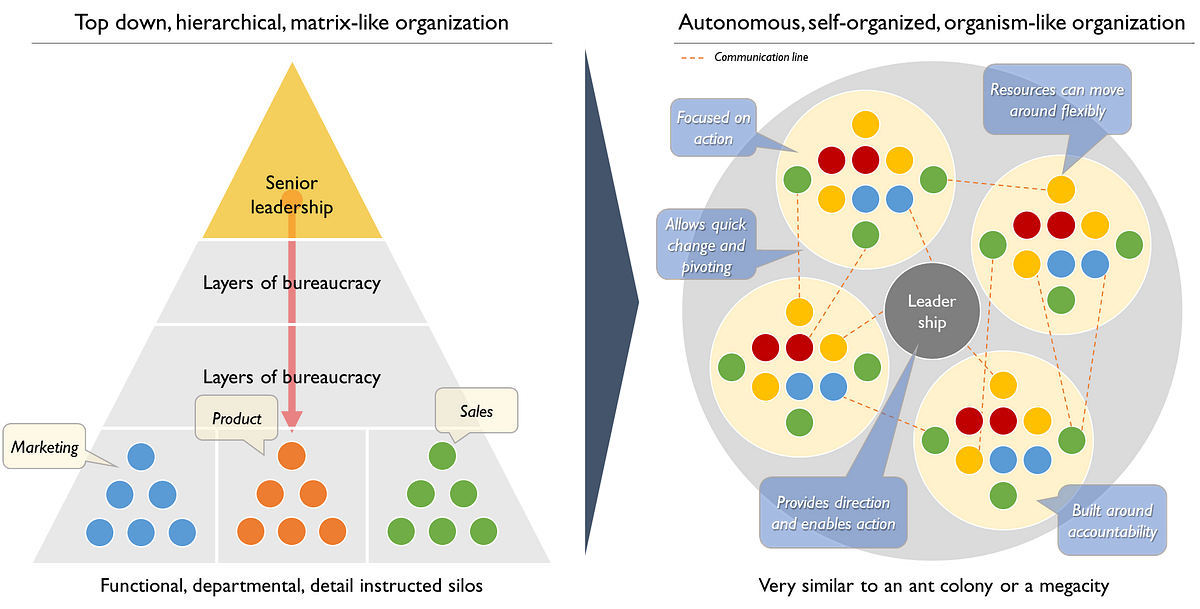Discover the secret behind Spotify’s success in achieving goals and skyrocket your OKRs with their groundbreaking tactics.

Table of Contents
- Understanding the Spotify Model
- Defining Specific OKRs
- Mapping OKRs to Squads and Chapters
- Fostering Collaboration and Knowledge Sharing through Guilds
- Ensuring Continuous Alignment and Adaptation
- Conclusion
Objectives and Key Results (OKRs) have become popular for setting goals and measuring organisational progress. The Spotify model, on the other hand, has gained recognition for its agile and collaborative approach to organizational structure. In this blog post, we will explore how you can effectively link OKRs to the Spotify model, amplifying the impact of both frameworks through alignment and focus.
Understanding the Spotify Model
The Spotify model is an organizational framework that promotes collaboration, autonomy, and agility. It divides teams into Squads, which are self-contained and cross-functional units. Squads then come together in Tribes, each focused on a different domain. Within Squads, individuals with similar skills form Chapters, enabling knowledge sharing and growth. Finally, Guilds promote cross-Squad collaboration and create an environment of continuous learning.
This model offers several benefits, including increased agility, improved collaboration, and better knowledge sharing. By linking OKRs to the Spotify model, organizations can further enhance their alignment and focus, enabling teams to work towards common goals while maintaining autonomy and adaptability.
Defining Specific OKRs
Objectives are the overarching goals that guide an organization or team, while Key Results are measurable outcomes that track progress towards those goals. When setting OKRs, it is crucial to ensure they are clear, specific, and quantifiable.
For example, an Objective could be to “Improve Customer Satisfaction.” Key Results could include metrics like “Increase Net Promoter Score by 10 points” or “Reduce customer support response time by 20%.”
When linking OKRs to the Spotify model, aligning them with the Squads and Chapters is essential. This ensures that each team has a clear focus and can contribute towards achieving the defined OKRs.
“Unleash the power of OKRs with the beat of the Spotify Model. 🎶📈 Discover how to amplify your success and achieve remarkable growth! #OKRs #SpotifyModel #SuccessUnleashed”
Mapping OKRs to Squads and Chapters
Mapping OKRs into Squads and Chapters is a critical step in the alignment process. It ensures that each team knows how their work directly contributes to the organization’s goals.

For example, if the OKR is focused on improving customer satisfaction, the Squad responsible for customer support should have this as their primary OKR. The Chapter members with relevant skills, such as customer service representatives, should also align their work with this objective.
Effective communication and transparency are key when linking OKRs to Squads and Chapters. Regular check-ins and feedback loops help ensure each team member understands their role and how it relates to the bigger picture.
Fostering Collaboration and Knowledge Sharing through Guilds
Guilds play a significant role in the Spotify model by facilitating cross-Squad collaboration and sharing knowledge and best practices. When linking OKRs to the Spotify model, organizations can leverage Guilds to enhance their impact further.
Engaging Guilds in the OKR process can involve sharing progress updates, seeking feedback, and collaborating on initiatives that align with the overall OKRs. For example, a Guild focused on customer success can provide valuable insights to Squads working on improving customer satisfaction.
By fostering collaboration and knowledge sharing through Guilds, organizations can maximize the expertise and creativity across teams, ultimately leading to better results.
Ensuring Continuous Alignment and Adaptation
OKRs and the Spotify model are not static; they should adapt to changing priorities and market conditions. Continuously reviewing and iterating on OKRs is essential to maintain alignment and focus.
Regular check-ins and feedback loops are valuable for reviewing OKRs and adapting them when necessary. By conducting periodic OKR reviews, teams can assess progress, identify challenges, and adjust their goals and Key Results accordingly.
Furthermore, organizations should encourage a culture of continuous evaluation and improvement. This includes providing avenues for feedback, fostering a sense of psychological safety, and recognizing achievements that support the OKRs.
Conclusion
Linking OKRs to the Spotify model can unlock powerful synergies within organizations. Organizations can enhance collaboration, accountability, and focus by aligning OKRs with Squads, Chapters, and Guilds.
Remember, effective OKRs are specific, measurable, and time-bound. Mapping them to the relevant teams and involving Guilds in the process can amplify the impact of both OKRs and the Spotify model. Furthermore, continuous alignment and adaptation ensure that goals remain relevant and achievable amidst changing circumstances.
So, whether you aim to improve customer satisfaction, launch a new product, or achieve any other business objective, consider harnessing the power of the Spotify model in combination with OKRs. Unlock the beat of success and amplify your organizational impact.